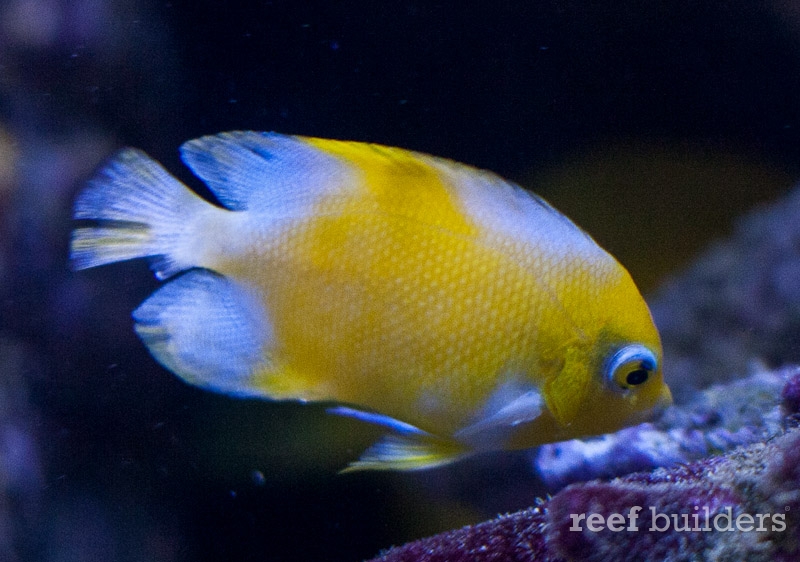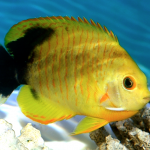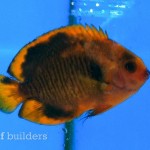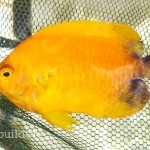The dwarf angelfishes of the Genera Centropyge and Paracentropyge are amongst our favorite reef fishes, in part for their fabulous array of colour morphs and hybrids. We’ve always been fascinated by the variety of these aberrant individuals, and seem to have come across something new!
On that note, I have to share this unusual Centropyge sp. that has turned up in a private collection in my care, in London. This small fish seems to have what can only be described as a ‘piebald’ colouration, unlike the more often seen, though by no means common, ‘Koi’ and xanthic aberrations. In my years as an aquarist, and from general trawling of books and the internet, I have yet to see another example of ‘piebalding’ like this in a dwarf angel.
While fish sporting the ‘Koi’ or xanthic morph often change, or even revert back to wild type colours, piebalding can be caused by a couple of different conditions: A true piebald animal has genetic mutations that, from its embryonic development, leave patches of its skin devoid of either colour producing cells or, the presence of these cells but the inability for them to function.
[singlepic id=10289 w= h= float=none]
The skin condition vitiligo, that occurs in people, could be said to be the most similar in terms of appearance to the mystery dwarf angel, as well as shed light on it’s potential cause. In humans suffering from vitiligo, white, melanin free patches appear on the skin; mostly the extremities, or areas exposed to the sun.
The vitiligo condition is not fully understood, but causes are thought to include auto-immune problems, overactive thyroid, or issues with the nerve endings in the skin. Unlike genetic piebaldism, vitiligo manifests later on in life, but in both cases the white skin patches are usually permanent.
After seeing this little fish, it got me thinking about the color morphs that Centropyge exhibit. If genetic piebaldism is the blanking out of areas on the body from EVER producing color, then what’s the deal with ‘Koi’ coloration, and the overly yellow, xanthic, dwarf angels?

One of the issues with ‘Koi’ and xanthic fish, is that they often change with time in the aquarium; in some cases reverting back to a classic color scheme more in keeping with their kin. Unusual color morphs, being rare and in turn highly desirable, do not always make for good value for money, if your prized mutant is going to change back to a bog standard example of its species!
This being the case, we must look past striking and stable genetic mutations like true piebaldism, and instead question environment, and possibly the specific physiological factors affecting the aberrantly colored individual, as in the case of a fish with vitiligo!
The most frequently encountered color pigments in fish are melanins, carotenoids, and purines. Purines (mostly guanine) are structural colors- crystalline substances that produce the sheen and reflective qualities of fish skin through interplay with light. But it is the melanins and carotenoids that give us the range of yellows to blacks when found in different combinations.
The production of these pigments would be down to the fish’s diet, while the utilization of these pigments is controlled by the fish’s nervous and endocrine systems. The chromatophores, pigment holding cells in the dermis, dictating the spread, or concentration of pigment in localized areas, respond to environmental, and in turn hormonal cues.
Therefore, perhaps fishes sporting ‘Koi’ coloration have a combination of dietary deficiency contributing to loss of one ‘channel’ of color pigmentation, or localized disruption to areas of chromatophores? In people, vitiligo manifests in the loss of melanin in the skin, but in the skin of a fish, with a greater interplay of pigments, perhaps we are seeing a greater variability of outcomes.
Stress, illness, physical trauma, or some other environmental factor, could be leading to the muting, so to speak, of part of their color scheme? Drop out the melanins from a multicolored fish, and we are left with a xanthic individual. Drop the carotenoids and adjust the purines, and we can encounter the blue morphs, most commonly seen in C. bicolor, C. bispinosus and C. potteri.

This could be the reason why the ‘Koi’ coloration is unstable, and changes or reverts over time. Environmental factors are subject to change and often in a state of flux, whereas in a condition like piebaldism, there is a genetic blank, with unpigmented areas left barren indefinitely. A fish with a most human-like case of vitiligo, may, like the aberrant Centropyge, exhibit white patches. But other fishes, tricolor scopas tangs spring to mind, may be showing symptoms of a different magnitude, but of the same condition.
One suggestion as to why angels have adopted a xanthic coloration has been offered due to breeding. Of course many species of fish take on nuptial dress, but it was suggested (by F. Walsh in the Debelius, Tanaka, Kuiter, 2003 book on Angelfishes) that aberrant xanthic morphs of Centropyge bicolor appear at certain times of the year during the peak of spawning. However, if this was the case, surely aberrant individuals would be more greatly noted?
[singlepic id=10290 w= h= float=none]
It seems unlikely that such unusual nuptial coloration would manifest in just a handful of individuals, in just a few species of what could be considered a closely related family. However, perhaps collecting pressure, having removed specimens that kept to an archetypal colour scheme, has left fish that display less than perfect colors to breed, raising the percentage of potentially aberrant genetics, and the propensity for a particular fish to exhibit variable coloration.
This theory has been put forward as to the apparent increase in aberrantly colored surgeonfish, and is certainly a plausible one in that case. I think it would be really interesting if the abundance and collection of these fishes, with their appearance in the trade, was noted, against data on their spawning activity, as this seems a good area for study.
[singlepic id=10292 w= h= float=none]
In regards to my London piebald angel, we are still unsure as to what species it actually is. C. flavissima is typically a bright lemon yellow fish with blue highlights around the eyes, fin margins and operculum. There seem to be remnants of these on our aberrant individual. At the same time, there is a strong argument for it being a C. heraldi, due to its facial profile, as well as the eye coloration. There is even the possibility of a C. flavissima x heraldi hybrid, upon which case, in regards to colouration, anything goes. It has certainly been observed that female C. flavissima change color to almost white during courtship and spawning.
In the case of this aberrant individual, the strong white patches, if caused by piebaldism, should remain that way. In the case of fish vitiligo, they may spread! Only time will tell. As so often is the case with these Centropyge color morphs, only time will tell.







